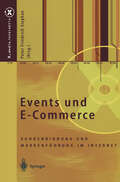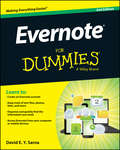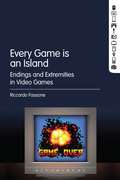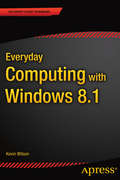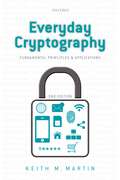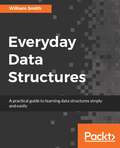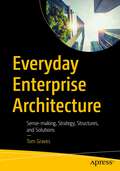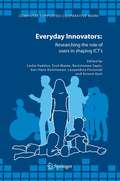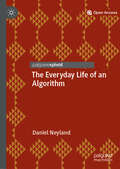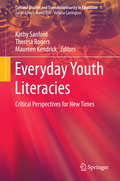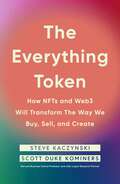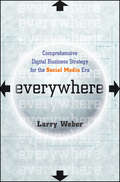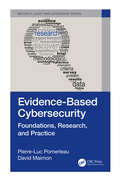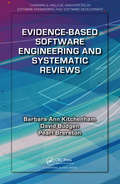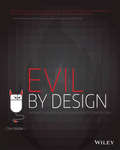- Table View
- List View
Event-Triggered Cooperative Control: Analysis and Synthesis
by Wenying Xu Daniel W. Ho Jinde CaoThe book provides a systematic and in-depth introduction to distributed event-triggered cooperative control for multi-agent systems from a theoretical perspective, which will be of particular interest to the readers. The included major research topics include: a unified design and analysis framework for centralized, clustered and distributed event-triggered schemes; fully distributed design for event/self-triggered schemes; resilient event-triggered control under malicious attacks; and various methods to aovid Zeno behavior. The comprehensive and systematic treatment of event-triggered communication and control in multi-agent system is one of the major features of the book, which is particularly suited for readers who are interested in learning principles and methods to deal with communication constraints in multi-agent systems and to design energy-saving control protocols. The book can benefit researchers, engineers, and graduate students in the fields of complex networks, smart grids, applied mathematics, electrical and electronic engineering, and computer engineering, etc.
Eventforschung: Events und ‚The New Normal' (Markenkommunikation und Beziehungsmarketing)
by Cornelia ZangerLive, digital und hybrid - Das New Normal steht für die Integration analoger und digitaler Kanäle. Die Beiträge in diesem Konferenzband gehen auf die erfolgreiche Verknüpfung von Medien im Umgang mit den aktuellen Herausforderungen in einem pandemischen Umfeld ein. Vor diesem Hintergrund zeigen Forscher und Branchenexperten Trends und Strategien der Event- und Messewirtschaft im Umfeld der Krise auf, beleuchten hochaktuelle Themen zur Nachhaltigkeit und diskutieren die zukünftigen Entwicklungen der Veranstaltungsbranche in den bevorstehenden Monaten und Jahren. Die Beiträge in diesem Tagungsband bieten vielfältige Handlungsempfehlungen für die Branche und geben Impulse für Forschung und Wissenschaft.
Eventforschung: Aktueller Stand und Perspektiven (Markenkommunikation und Beziehungsmarketing)
Die Autorinnen und Autoren des Tagungsbandes ziehen anlässlich des 10-jährigen Jubiläums der Wissenschaftlichen Konferenz Eventforschung Bilanz und werfen gleichzeitig einen Blick in die Zukunft der Live Communication. Das Schwerpunktthema „10 Jahre Eventforschung“ wird mit vielfältigen wissenschaftlichen und praxisorientierten Beiträgen, u. a. zur Digitalisierung, zur Arbeitssituation in der Branche, zum agilen Projektmanagement, zum Datenschutzrecht sowie zur Nachhaltigkeit, bearbeitet. Dieser Band fasst die auf der 10. Eventkonferenz, die am 26. Oktober 2018 an der TU Chemnitz stattfand, vorgestellten und diskutierten Forschungsergebnisse und Praxisbeispiele zusammen.
Events und E-Commerce: Kundenbindung und Markenführung im Internet (X.media.interaktiv)
by Peter F. StephanDer digitale Marktplatz Internet bietet neue Möglichkeiten der Kundenbindung und Markenführung. Das Buch stellt Konzept, Ästhetik und Technik innovativer Kampagnen in zahlreichen Fallstudien dar. Praktiker und Konzeptioner finden hier erstmals umfangreiches Anschauungsmaterial, "best practice"-Beispiele und spannende Ausblicke auf die Trends im Wachstumsmarkt Corporate Communication.
Events und Erlebnis: Stand und Perspektiven der Eventforschung (Markenkommunikation und Beziehungsmarketing)
by Cornelia ZangerDie Autorinnen und Autoren des Tagungsbandes liefern aus Sicht des Marketing, der Kommunikationstheorie sowie der Medienwissenschaften Erklärungsansätze für das Entstehen und Wirken von Erlebnissen im Eventkontext. Der Band fasst die auf der achten Wissenschaftlichen Konferenz zur Eventforschung, die am 28. Oktober 2016 an der TU Chemnitz stattfand, vorgestellten und diskutierten aktuellen Forschungsergebnisse zum Thema Events und Erlebnis zusammen. Das Schwerpunktthema wird ergänzt um wissenschaftliche und praxisorientierte Beiträge u. a. zum Messecontrolling, zu Events im Innovationsmanagement, zur Digitalisierung in der Live-Kommunikation oder zum Markenschutz.
Evernote For Dummies
by David E. SarnaOrganize your life the simple, painless way with Evernote! Evernote makes it easy to remember things big and small using your computer, smartphone, or the web. If you can see it or think of it, Evernote can help you remember it! Now you can type a text note, clip a web page, snap a photo, or grab a screenshot and Evernote will keep it all. Through Evernote, you can tap into a free suite of software and services designed to make note taking and archiving simple. Now you'll be able to easily capture any moment, idea, inspiration, or experience no matter what device or platform you are using. The Second Edition of this bestselling book is revised throughout to cover the latest features, updates, and enhancements made to Evernote! Follow the simple steps to quickly register and set up your Evernote account Discover how easy it is to move and organize notes Access all your information on your computer, the web, smartphone, tablet, or e-reader Explore Evernote's open scripting and explore how to be an Evernote developer Evernote For Dummies, 2nd Edition is the ideal reference to help you take control of your life and get organized with Evernote. This handy guide makes it a breeze use Evernote to store, organize, and access practically anything, everywhere.
Evernote For Dummies
by David E. SarnaOrganize your life the simple, painless way with Evernote! Evernote makes it easy to remember things big and small using your computer, smartphone, or the web. If you can see it or think of it, Evernote can help you remember it! Now you can type a text note, clip a web page, snap a photo, or grab a screenshot and Evernote will keep it all. Through Evernote, you can tap into a free suite of software and services designed to make note taking and archiving simple. Now you'll be able to easily capture any moment, idea, inspiration, or experience no matter what device or platform you are using. The Second Edition of this bestselling book is revised throughout to cover the latest features, updates, and enhancements made to Evernote! Follow the simple steps to quickly register and set up your Evernote account Discover how easy it is to move and organize notes Access all your information on your computer, the web, smartphone, tablet, or e-reader Explore Evernote's open scripting and explore how to be an Evernote developer Evernote For Dummies, 2nd Edition is the ideal reference to help you take control of your life and get organized with Evernote. This handy guide makes it a breeze use Evernote to store, organize, and access practically anything, everywhere.
Every Game is an Island: Endings and Extremities in Video Games
by Riccardo FassoneDespite the pervasive rhetorics of immersion and embodiment found in industrial and social discourses, playing a video game is an exercise in non-linearity. The pervasiveness of trial and error mechanics, unforgiving game over screens, loading times, minute tweakings of options and settings, should lead us to consider video games as a medium that cannot eschew fragmentation. Every Game is an Island is an analysis and a critique of grey areas, dead ends and extremities found in digital games, an exploration of border zones where play and non-play coexist or compete. Riccardo Fassone describes the complexity of the experience of video game play and brings integral but often overlooked components of the gameplay experience to the fore, in an attempt to problematize a reading of video games as grandiosely immersive, all-encompassing narrative experiences. Through the analysis of closures and endings, limits and borders, and liminal states, this field-advancing study looks at the heart of a medium starting from its periphery.
Every Game is an Island: Endings and Extremities in Video Games
by Riccardo FassoneDespite the pervasive rhetorics of immersion and embodiment found in industrial and social discourses, playing a video game is an exercise in non-linearity. The pervasiveness of trial and error mechanics, unforgiving game over screens, loading times, minute tweakings of options and settings, should lead us to consider video games as a medium that cannot eschew fragmentation. Every Game is an Island is an analysis and a critique of grey areas, dead ends and extremities found in digital games, an exploration of border zones where play and non-play coexist or compete. Riccardo Fassone describes the complexity of the experience of video game play and brings integral but often overlooked components of the gameplay experience to the fore, in an attempt to problematize a reading of video games as grandiosely immersive, all-encompassing narrative experiences. Through the analysis of closures and endings, limits and borders, and liminal states, this field-advancing study looks at the heart of a medium starting from its periphery.
Everyday Computing with Windows 8.1
by Kevin WilsonGet the most out of Windows 8.1 for your every day computing tasks, with no jargon. Clear, concise and to the point. This brief book, Everyday Computing With Windows 8.1 provides the essentials of using a desktop or laptop running Windows 8 or 8.1, providing a fast read for the beginner and the enthusiast. Windows 8 can give new users fits with options that are well hidden; this book uncovers those so that the user can be relieved of frustration.Techniques are illustrated step-by-step using photography and screen prints throughout, together with concise, easy to follow explanations from an established expert in the field.Whether you have just bought your first computer or laptop or are a computer user who needs a better understanding of the basics, this book will provide you with a firm grasp of the underpinning foundations and equip you with the skills needed to take command of your computer.
Everyday Cryptography: Fundamental Principles and Applications
by Keith MartinCryptography is a vital technology that underpins the security of information in computer networks. This book presents a comprehensive introduction to the role that cryptography plays in providing information security for everyday technologies such as the Internet, mobile phones, Wi-Fi networks, payment cards, Tor, and Bitcoin. This book is intended to be introductory, self-contained, and widely accessible. It is suitable as a first read on cryptography. Almost no prior knowledge of mathematics is required since the book deliberately avoids the details of the mathematics techniques underpinning cryptographic mechanisms. Instead our focus will be on what a normal user or practitioner of information security needs to know about cryptography in order to understand the design and use of everyday cryptographic applications. By focusing on the fundamental principles of modern cryptography rather than the technical details of current cryptographic technology, the main part this book is relatively timeless, and illustrates the application of these principles by considering a number of contemporary applications of cryptography. Following the revelations of former NSA contractor Edward Snowden, the book considers the wider societal impact of use of cryptography and strategies for addressing this. A reader of this book will not only be able to understand the everyday use of cryptography, but also be able to interpret future developments in this fascinating and crucially important area of technology.
Everyday Cryptography: Fundamental Principles and Applications
by Keith MartinCryptography is a vital technology that underpins the security of information in computer networks. This book presents a comprehensive introduction to the role that cryptography plays in providing information security for everyday technologies such as the Internet, mobile phones, Wi-Fi networks, payment cards, Tor, and Bitcoin. This book is intended to be introductory, self-contained, and widely accessible. It is suitable as a first read on cryptography. Almost no prior knowledge of mathematics is required since the book deliberately avoids the details of the mathematics techniques underpinning cryptographic mechanisms. Instead our focus will be on what a normal user or practitioner of information security needs to know about cryptography in order to understand the design and use of everyday cryptographic applications. By focusing on the fundamental principles of modern cryptography rather than the technical details of current cryptographic technology, the main part this book is relatively timeless, and illustrates the application of these principles by considering a number of contemporary applications of cryptography. Following the revelations of former NSA contractor Edward Snowden, the book considers the wider societal impact of use of cryptography and strategies for addressing this. A reader of this book will not only be able to understand the everyday use of cryptography, but also be able to interpret future developments in this fascinating and crucially important area of technology.
Everyday Data Structures
by William SmithA practical guide to learning data structures simply and easily About This Book • This book is a very practical, friendly, and useful guide that will help you analyze problems and choose the right data structures for your solution • Learn to recognize data patterns for determining which structures apply to a given problem • Explore the unique rules or "gotchas" that will help you become an excellent programmer Who This Book Is For If you're self-taught programmers in any language who wants to gain a solid understanding of data structures and how to use them to solve real-world problems in your day-to-day development work, then this book is for you. What You Will Learn • A rapid overview of data types, applications for each type, best practices and high-level variations between platforms • Review the most common data structures and build working examples in the languages used for mobile platform software development • Understand advanced data structure concepts such as generic collections, searching and sorting algorithms, and recursion • Learn to use Stacks (LIFO) and queues (FIFO) in your daily application • Add/remove objects and nest arrays and dictionaries within another dictionary and understand why such architecture is often preferred or necessary • Get acquainted with the tree structures such as heap, binary, and graphs, apply them to work • Unleash the power of different sorting techniques such as bubble sort, quick sort, merge sort, insertion sort, and radix sort • Perform searching operations on arrays, heaps, graphs, and binary trees in different languages In Detail If you want to learn different data structures and their real-world applications quickly through practical examples, then Everyday Data Structures is for you. This book can introduce you to new data structures and their potential applications through examples in languages common to mobile software development on the most popular platforms. The examples are presented with real-world concepts using language that everyone will understand. This book is logically divided into two parts; the first one covers the basic data structures that are built into most languages such as Objective-C, C#, Java, and Swift. It will cover detailed analysis of the common data structures such as arrays, lists, stacks, Queues, and heaps, typical applications, and specific concerns for each language. Each chapter will provide in-depth examples in several popular languages based on real-world applications. The second part will cover more advanced data structures such as generic collections, sorting, searching, and recursion and ways to use those structures in everyday applications. Style and approach This is a practical, result-focused guide, which is easy to follow, but also fast-paced and really satisfying with full of examples.
Everyday Enterprise Architecture: Sense-making, Strategy, Structures, and Solutions
by Tom GravesDiscover what needs to happen in enterprise-architecture practice—and not just its outcomes, but also the activities from which those outcomes would arise. This book reveals how business and enterprise architects can deliver fast solutions to an always-on-the-go business world.To begin, you'll review a new technique called "context-space mapping," which provides a structured method for sense-making across the entire context of an enterprise. Throughout the book, you'll concentrate on the routine practices that underpin each of the architecture disciplines. Working step-by-step through a real 10-day architecture project, this book explores the activities that underpin the strategy, structures and solutions in the real-time turmoil of an enterprise architect’s everyday work. You'll explore how and why and when the various documents, artefacts and items of ‘theory-stuff’ come into the practice – all those mainstream methods, frameworks, models, metamodels and other information sources. In the end, Everyday Enterprise Architecture will help you develop the skills, judgment, and awareness to keep enhancing the value of your architectural projects. What You'll LearnWork on architectures at "business-speed"Adapt architectures for different tasksGather, use, and manage architectural informationWho This Book Is ForEnterprise and business architects.
Everyday Innovators: Researching the Role of Users in Shaping ICTs (Computer Supported Cooperative Work #32)
by Kari-Hans Kommonen Leopoldina Fortunati Annevi Kant Leslie Haddon Enid Mante Bartolomeo SapioEveryday Innovators explores the active role of people, collectively and individually, in shaping the use of information and communication technologies. It examines issues around acquiring and using that knowledge of users, how we should conceptualise the role of users and understand the forms and limitations of their participation. To what extent should we think of users as being innovative and creative? To what extent is this routine or exceptional, confined to particular group of users or part of many people’s experience of technologies? Where does the nature of the ICT or the particularities of its design impose constraints on the active role that users can play in their interaction with devices and services? Where do the horizons and orientations of the users influence or limit what they want and expect of their ICTs and how they use them? This book enables a cross-fertilisation of perspectives from different disciplines and aims to provide new insights into the role of users, drawing out both applied and theoretical implications
The Everyday Life of an Algorithm
by Daniel NeylandThis open access book begins with an algorithm–a set of IF…THEN rules used in the development of a new, ethical, video surveillance architecture for transport hubs. Readers are invited to follow the algorithm over three years, charting its everyday life. Questions of ethics, transparency, accountability and market value must be grasped by the algorithm in a series of ever more demanding forms of experimentation. Here the algorithm must prove its ability to get a grip on everyday life if it is to become an ordinary feature of the settings where it is being put to work. Through investigating the everyday life of the algorithm, the book opens a conversation with existing social science research that tends to focus on the power and opacity of algorithms. In this book we have unique access to the algorithm’s design, development and testing, but can also bear witness to its fragility and dependency on others.
Everyday Youth Literacies: Critical Perspectives for New Times (Cultural Studies and Transdisciplinarity in Education #1)
by Kathy Sanford Theresa Rogers Maureen KendrickTestifying to the maturity of the youth literacy education field, this collection of papers displays the increasing sophistication of research on the subject, and at the same time offers pointers to its potential for development in the next decade. The contributors track the rapid proliferation of youth literacies in today’s digital age, from video games to social media and film production. Drawing on detailed research and an intimate knowledge of youth communities in nations as diverse as Canada and Uganda, they provide notable examples of digital literacies in situ, and challenge conventional wisdom about literacy education.The chapters do more, however, than merely offer reportage of a crisis in literacy education. The authors embrace the core challenge faced by educators everywhere: how to incorporate and utilize new modes of literacy in education, and how to realize the potential benefits of heterogeneous modern media in youth literacy education, especially in marginalized, remote, and disadvantaged communities. This volume expands our view of digital communications technologies and digital literacies to include complex understandings of how media such as translated videos can serve as learning tools for youths whose access to literacy education is limited. In particular, a number of contributing scholars provide important new information about the praxis of teachers and the literacies adopted by young people in Africa, a continent largely neglected by literacy researchers. This book’s global perspective, and its ground-level viewpoint of youth literacy practices in a variety of locations, problematizes normative assumptions about researching literacy as well as about literacy itself.
The Everything Token: How NFTs and Web3 Will Transform the Way We Buy, Sell, and Create
by Steve Kaczynski Scott Duke KominersNFTs cause excitement and skepticism. How much value can a token hold? What drives this value?To properly appreciate NFTs we must first understand what they actually are, how they work and in what contexts they are used.The Everything Token is an essential primer on NFTs (non-fungible tokens), explaining their use, purpose, and how businesses can create and exploit them to develop new product lines, building customer loyalty and increased revenues at the same time.Together the authors have spent much of the past few years embedded in NFT communities and helping launch NFT products. As self-described beta testers of this brand-new technology, they’ve seen its power first-hand and aim to educate others on the importance, uses and purpose of NFT and surrounding, ever-evolving technologies.Demystifying the complexities, two experts in NFTs show why we should take NFTs much more seriously than their reputation as fun digital art collectibles suggest. They have a wider variety of uses than one may realise.Gripping and accessible, this book provides a guide and an insight into what can often be a hard-to-grasp area of technology.
Everything You Need to Master Minecraft Earth: The Essential Guide to the Ultimate AR Game
by Ed JeffersonMinecraft Earth is the worldwide mobile gaming phenomenon. Now you can get ahead of the game with Everything You Need to Master Minecraft Earth, the essential guide to the Augmented Reality spin-off. You don't have to travel far to take your on-screen builds into the real world – learn how to craft amazing structures in your own living room, back garden and beyond.This unofficial book contains everything you need to master the game, including: Tips on how to build up your collection of blocks, mobs and rare items by finding Tappables. Build Plate ideas that will help you to craft incredible small-scale Augmented Reality structures with your friends - before placing them life-size into the real world. Hints on how to master Minecraft Earth Adventures, in which you can explore a Minecraft AR structure, solve tricky puzzles or battle hordes of Minecraft mobs in the world around you. A complete guide to all the mobs you'll meet, including the new types developed specifically for Minecraft Earth.
Everywhere: Comprehensive Digital Business Strategy for the Social Media Era
by Larry WeberPut digital business strategy at the center of your business Welcome to the social media age. Although its impact was first felt in the marketing department, the social web is spreading across all business functions, impacting the way they communicate, operate, organize, and create value. A comprehensive digital strategy is essential for businesses hoping to build this new form of competitive advantage. Everywhere explains how to put your digital strategy at the center of how your organization communicates, operates, organizes itself, and creates value. Develop a comprehensive digital strategy for your organization Put your online business strategy at the center of your customer's experience, and at the heart of everything you do Larry Weber's W2 Group is helping companies like Sony, IBM, Harvard Pilgrim Health Care, and the government of Rwanda, craft new online business strategies The Web is not just another marketing channel. Put social media, email, Web, and other digital interactions Everywhere in your business, and make digital business strategy the heart of your thriving enterprise.
Everywhere: Comprehensive Digital Business Strategy for the Social Media Era
by Larry WeberPut digital business strategy at the center of your business Welcome to the social media age. Although its impact was first felt in the marketing department, the social web is spreading across all business functions, impacting the way they communicate, operate, organize, and create value. A comprehensive digital strategy is essential for businesses hoping to build this new form of competitive advantage. Everywhere explains how to put your digital strategy at the center of how your organization communicates, operates, organizes itself, and creates value. Develop a comprehensive digital strategy for your organization Put your online business strategy at the center of your customer's experience, and at the heart of everything you do Larry Weber's W2 Group is helping companies like Sony, IBM, Harvard Pilgrim Health Care, and the government of Rwanda, craft new online business strategies The Web is not just another marketing channel. Put social media, email, Web, and other digital interactions Everywhere in your business, and make digital business strategy the heart of your thriving enterprise.
Evidence-Based Cybersecurity: Foundations, Research, and Practice (Security, Audit and Leadership Series)
by Pierre-Luc Pomerleau David MaimonThe prevalence of cyber-dependent crimes and illegal activities that can only be performed using a computer, computer networks, or other forms of information communication technology has significantly increased during the last two decades in the USA and worldwide. As a result, cybersecurity scholars and practitioners have developed various tools and policies to reduce individuals' and organizations' risk of experiencing cyber-dependent crimes. However, although cybersecurity research and tools production efforts have increased substantially, very little attention has been devoted to identifying potential comprehensive interventions that consider both human and technical aspects of the local ecology within which these crimes emerge and persist. Moreover, it appears that rigorous scientific assessments of these technologies and policies "in the wild" have been dismissed in the process of encouraging innovation and marketing. Consequently, governmental organizations, public, and private companies allocate a considerable portion of their operations budgets to protecting their computer and internet infrastructures without understanding the effectiveness of various tools and policies in reducing the myriad of risks they face. Unfortunately, this practice may complicate organizational workflows and increase costs for government entities, businesses, and consumers. The success of the evidence-based approach in improving performance in a wide range of professions (for example, medicine, policing, and education) leads us to believe that an evidence-based cybersecurity approach is critical for improving cybersecurity efforts. This book seeks to explain the foundation of the evidence-based cybersecurity approach, review its relevance in the context of existing security tools and policies, and provide concrete examples of how adopting this approach could improve cybersecurity operations and guide policymakers' decision-making process. The evidence-based cybersecurity approach explained aims to support security professionals', policymakers', and individual computer users' decision-making regarding the deployment of security policies and tools by calling for rigorous scientific investigations of the effectiveness of these policies and mechanisms in achieving their goals to protect critical assets. This book illustrates how this approach provides an ideal framework for conceptualizing an interdisciplinary problem like cybersecurity because it stresses moving beyond decision-makers' political, financial, social, and personal experience backgrounds when adopting cybersecurity tools and policies. This approach is also a model in which policy decisions are made based on scientific research findings.
Evidence-Based Cybersecurity: Foundations, Research, and Practice (Security, Audit and Leadership Series)
by Pierre-Luc Pomerleau David MaimonThe prevalence of cyber-dependent crimes and illegal activities that can only be performed using a computer, computer networks, or other forms of information communication technology has significantly increased during the last two decades in the USA and worldwide. As a result, cybersecurity scholars and practitioners have developed various tools and policies to reduce individuals' and organizations' risk of experiencing cyber-dependent crimes. However, although cybersecurity research and tools production efforts have increased substantially, very little attention has been devoted to identifying potential comprehensive interventions that consider both human and technical aspects of the local ecology within which these crimes emerge and persist. Moreover, it appears that rigorous scientific assessments of these technologies and policies "in the wild" have been dismissed in the process of encouraging innovation and marketing. Consequently, governmental organizations, public, and private companies allocate a considerable portion of their operations budgets to protecting their computer and internet infrastructures without understanding the effectiveness of various tools and policies in reducing the myriad of risks they face. Unfortunately, this practice may complicate organizational workflows and increase costs for government entities, businesses, and consumers. The success of the evidence-based approach in improving performance in a wide range of professions (for example, medicine, policing, and education) leads us to believe that an evidence-based cybersecurity approach is critical for improving cybersecurity efforts. This book seeks to explain the foundation of the evidence-based cybersecurity approach, review its relevance in the context of existing security tools and policies, and provide concrete examples of how adopting this approach could improve cybersecurity operations and guide policymakers' decision-making process. The evidence-based cybersecurity approach explained aims to support security professionals', policymakers', and individual computer users' decision-making regarding the deployment of security policies and tools by calling for rigorous scientific investigations of the effectiveness of these policies and mechanisms in achieving their goals to protect critical assets. This book illustrates how this approach provides an ideal framework for conceptualizing an interdisciplinary problem like cybersecurity because it stresses moving beyond decision-makers' political, financial, social, and personal experience backgrounds when adopting cybersecurity tools and policies. This approach is also a model in which policy decisions are made based on scientific research findings.
Evidence-Based Software Engineering and Systematic Reviews
by Barbara Ann Kitchenham David Budgen Pearl BreretonIn the decade since the idea of adapting the evidence-based paradigm for software engineering was first proposed, it has become a major tool of empirical software engineering. Evidence-Based Software Engineering and Systematic Reviews provides a clear introduction to the use of an evidence-based model for software engineering research and practice.
Evil by Design: Interaction Design to Lead Us into Temptation
by Chris NodderHow to make customers feel good about doing what you want Learn how companies make us feel good about doing what they want. Approaching persuasive design from the dark side, this book melds psychology, marketing, and design concepts to show why we’re susceptible to certain persuasive techniques. Packed with examples from every nook and cranny of the web, it provides easily digestible and applicable patterns for putting these design techniques to work. Organized by the seven deadly sins, it includes: Pride — use social proof to position your product in line with your visitors’ values Sloth — build a path of least resistance that leads users where you want them to go Gluttony — escalate customers’ commitment and use loss aversion to keep them there Anger — understand the power of metaphysical arguments and anonymity Envy — create a culture of status around your product and feed aspirational desires Lust — turn desire into commitment by using emotion to defeat rational behavior Greed — keep customers engaged by reinforcing the behaviors you desire Now you too can leverage human fallibility to create powerful persuasive interfaces that people will love to use — but will you use your new knowledge for good or evil? Learn more on the companion website, evilbydesign.info.



